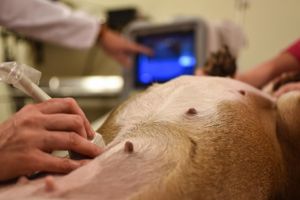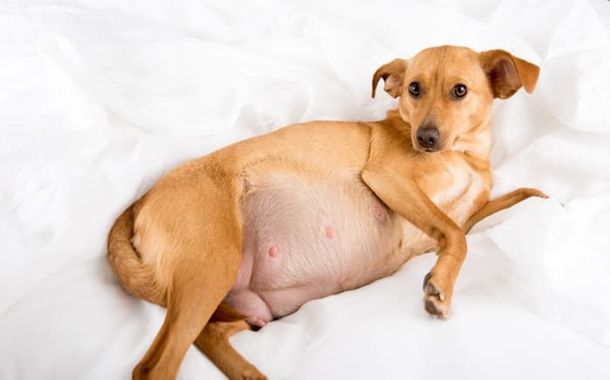How Much Does Dog C Section Cost?
Last Updated on November 24, 2023
Written by CPA Alec Pow | Content Reviewed by ![]() CFA Alexander Popinker
CFA Alexander Popinker
Bringing helpless little bundles of fluff into this world is no easy task, even for pro breeders. Few dogs birth without challenges, and unfortunately, emergencies happen. Complications often lead veterinarians to perform urgent, even lifesaving cesarean sections. But how much does a dog C-section cost? Does insurance cover these major procedures? Where does pricing range? Use this assisted guidance to learn about the unknowns around painful dog C-sections to budget accurately while avoiding overpriced services.
How Much Does Dog C Section Cost?
The average dog C-section procedure costs $500-$4,000, fluctuating based on veterinary clinic locations, surgery extent, needed hospitalizations, and other influencing factors we’ll cover. Specifically, costs are divided into:
Planned, “elective” procedures starting at around $500-$1,000. These pre-scheduled C-sections prove gentler with less trauma and quicker operating and recovery times.
Emergency surgery often demanding extensive reconstruction care and costing between $1,500 to $4,000+. Rushing into unplanned complex C-sections with little medical history risks grave dangers to all involved, hence such urgent elevated investments are very much essential.
Because of the complex biology, available supplies, and technicians’ pre-existing schedules dictating hospitals’ abilities to respond rapidly to crises, comparing multiple centers before emergencies helps you identify affordable quality care.
Hepper notes that the average price for a dog Cesarean section in 2023 is $1,000 to $3,000. The price will vary according to the state you are in, what the vet decides to charge, the health of your dog, the age of your dog, and if the procedure has complications.
Fetchpet, on the other hand, states that on average, a C-section costs between $500 to $4,000.
Papaya Veterinary Care has an article in which it reports that at the lower end of the scale, you can expect to spend around $1,000, though if you plan ahead, you could pay less. In some cases, such as an emergency c-section after-hours, you may pay as much as $3,000+. The final total will depend on factors including the vet, the location, the size of the dog, and the dog’s health status.
Be sure you ask for all-inclusive estimates accounting for anesthesia, incubators, fluid therapies, and medications facilitating smooth recoveries. As beloved family and profit-driving members, continued care for recovering moms and puppies is a thing you shouldn’t ignore. Fortunately, compassion still influences most veterinary pricing plans.
Factors Influencing Dog Cesarean Section Costs
- Type of Facility – Emergency veterinary hospitals charge premium rates given 24/7 nurse teams, specialized surgical equipment, and critical care capabilities spanning X-rays, MRIs, ultrasounds, and full inpatient care required saving dogs from dire circumstances versus standard vet clinics lacking such resources. Expect added costs but understand why through improved transparency.
- Procedure Extent − Simple planned C-sections start around $500 while complex reconstructions rectifying emergent complications like prolapsed uteruses may exceed $4,000 and require transfusions or hysterectomies. Pray such worst cases don’t happen to your precious pups but budget for this just in case.
- Hospitalization Stays – Most C-section dogs require 1-3 days to recover under veterinary supervision depending on sedation reactions, nursing acceptance, infection risk, and incision healing. Care runs $50-$150 per night further influencing overall investment so ask if releasing the next day seems plausible.
- Location – Available supplies, wage rates, and real estate dictate regional discrepancies, but don’t assume most expensive translates to best care. Prioritize surgical aptitudes first when emergencies strike then optimize economics by transferring across centers later once vitals stabilize if your budget can’t hold a full recovery in a more expensive center.
Surgical Complications Add Costs Quickly
Beyond the C-section itself, additional charges accumulate rapidly if difficulties emerge:
- Transfusions/Fluid IVs – Replacing lost blood volume and electrolytes during long procedures prevents shock or seizures, costing $200-$800 in materials and monitoring needs. But understand such investments save lives most of the time. Just focus on what matters most – healthy, happy dogs.
- Prescriptions − Antibiotics and pain management medications like Zofran and Rimadyl run $30-$75 but facilitate recoveries and let dogs walk comfortably again. When your budget is limited, just ask about generics or lower-cost alternatives if branding prices seem too high. Also, request oral versions avoiding added administration fees when this is possible.
- Embolization – Rarely, actively bleeding spleenic or uterine tears require emergency minimally invasive artery plugging to control internal hemorrhaging via fluoroscopy imaging. This can cost $800+. It’s the canine equivalent of angiograms in people with all the vascular complexity. However such acute interventions stabilize dogs rapidly.
Request itemized surgical fee estimates accounting for ordinary variable expenses like above so total costs never shock during already traumatic circumstances.
Does Pet Insurance Cover Dog C-Sections?
 Unfortunately, most pet insurance companies classify breeding and pregnancy care as pre-existing conditions excluded from policies. A few names like Fetch offer Breeding Supplement Riders covering complications exceeding $500 like emergency C-sections costing 30%+ more in premiums for robust breeding dogs producing large litters yearly.
Unfortunately, most pet insurance companies classify breeding and pregnancy care as pre-existing conditions excluded from policies. A few names like Fetch offer Breeding Supplement Riders covering complications exceeding $500 like emergency C-sections costing 30%+ more in premiums for robust breeding dogs producing large litters yearly.
You might also like our articles about the cost of hernia surgery, broken nail treatment, or entropion surgery for dogs.
But repeated planned C-sections still lack qualification across pet insurance providers given deliberate pre-existing health status. Continuous cycles of intensive mothering still wear down breeding dogs’ bodies in ways threatening entire bloodlines eventually.
So take reasonable precautions through scheduled aging-out of breeding cycles allowing sufficient recovery between litters supported by insurance or self-funded savings. No puppy profits prove worth losing irreplaceable maternal lines over by rushing delicate processes compounding exhaustion over time.
For personal pets enduring unexpected singular mothering situations, applications after costly C-sections still authorize future coverage for most conditions if underwriting passes within 30 days.
But you should know that policies always deny further pregnancy claims regardless given innate “pre-existing” designations. Ultimately spending $500 annually on comprehensive insurance from early puppyhood could have saved thousands long-term.
How To Reduce Veterinary Costs for Dog C-Section
If quoted C-section costs for your pregnant dog still stretch your budget despite insurance gaps, several tactics can be used to ensure cost savings:
- Spay dogs early ending pregnancy possibility altogether.
- Learn breeding dog health needs thoroughly before attempts.
- Start pet health savings funds or apply for 0% financing.
- Research prices across multiple area vets before emergencies strike.
- Transfer recovered dogs to general practices avoiding overnight fees.
- Purchase memberships offering 25%+ discounts on procedures.
Final Words
While expecting female dogs undoubtedly deserve exceptional surgical and recovery care when bringing new offspring bundles into the world, there are still some creative solutions to help you avoid financial burdens through proper planning. Protect all pups and pet parents economically by looking for options proactively around location, transfers, discounts, and financing should unforeseen events occur. Stay strong and carry on courageously.


Leave a Reply
Want to join the discussion?Feel free to contribute!